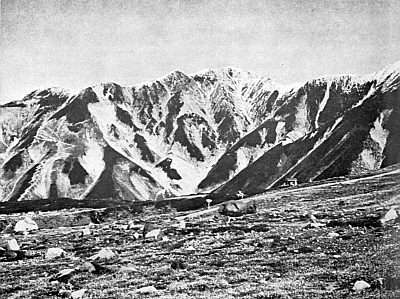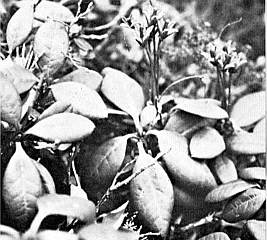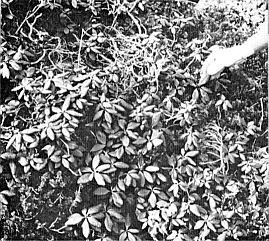QBARS - v26n2 Rhododendron aureum: A Short Photograph Album
Rhododendron aureum: A short Photograph Album
Frank Doleshy, Seattle, Washington
Republication rights reserved by the author.
After observing Rhododendron aureum at only two locations in Japan, and not during the flowering season, Mrs. Doleshy and I can hardly pose as experts on this species. Indeed, we have seen only a minute portion of its vast range from western Siberia to the islands off the north coast of Japan, and our knowledge of the plant has largely come from an excellent account in the October, 1970 issue of this Bulletin : "Four Asiatic Rhododendrons", by Vladimir Vasak, CSc.
The only real reason for writing this note is the scarcity of published photographs showing the species as it grows in the wild. Aside from two such photos in the above mentioned article, we have only seen one in a Swedish publication and one in a Japanese publication. This concerns us, because, when trying to prepare a hospitable growing site for a particular species in our garden, we find that such shots of wild plants are usually the best source of ideas. Therefore, we present these with the hope that they will help other growers.
First, concerning the name, Mr. Vasak points out that R. aureum is correct, since it was published first, although " R. chrysanthum " is widely used. The latter seems to have become an entrenched tradition in Britain, but R. aureum is used in recent publications from Japan, and it is perhaps best to start with the right name while the plant is still rather scarce and little-known in this country.
Our two observations were at Mt. Tateyama and Mt. Norikura, respectively located at the north and south ends of the Hida Mountain Range, or "Northern Alps". (See Jan. 1972 issue for location map.) In both places, the specialized life-zone was new to us and not at all like the wind-denuded ridges of Yakushima or the alpine meadows of NE Honshu. Here in the Hidas, at elevations above 8,000 feet or so, one sees splotches of blackish-green color on the mountain slopes, separated by areas of bare rock or thin, grassy vegetation. From a mile or two away, the contrast is so sharp that the splotches almost appear to be artificially painted; they consist of Pinus pumila and associated plants including the R. aureum .
|
||||
|
At these places, the Pine is usually from ankle-high to chest-high, and occasionally to 6 or 7 feet. The R. aureum may be mixed in, appearing as a creeper on taller rocks or the steep parts of the slope or it may form cushions as much as 8 or 10 feet across, beside the Pine thicket (Fig. 40). Also, it seems able to thrive at heights and exposures where the Pine starts to falter. In these high thickets, the Rhododendron may not really be an under story plant, and it is sometimes as dominant as the Pine in the local community. However, we did not see it anywhere more than 15 or 20 feet from the Pine.
Hearing about these thickets, people naturally try to think of them as something like an ordinary Pine forest, with layers of decaying needles on the ground. However, there is no real similarity. The little Pinus pumila can only produce a small volume of needle drop, and this is likely to be carried off by the wind. Therefore, instead of a forest-floor cushion underfoot, one finds a tight community of sub-shrubs and herbaceous plants. With the R. aureum , we usually saw Gaultheria miqueliana and the Lingonberry, Vaccinium vitis - idaea , together with the round, shiny, maroon or bright-red leaves of Shortia soldanelloides . Also, high on Mt. Norikura, other companion plants were the rather rare Arcterica nana and the heather-like but black-berried Empetrum nigrum . Moreover, when visiting this biotic community, it was impossible to ignore the ptarmigans, which were in process of changing to their winter plumage and practically underfoot.
Both of these places truly needed a second visit. However, on Tateyama, we were defeated by road rebuilding when we tried to go up again from the opposite side of the mountain range. And, on Norikura, our second try had to be called off when the new snow at 6000 feet was too deep to push through. Therefore, additional observations must await another trip.



